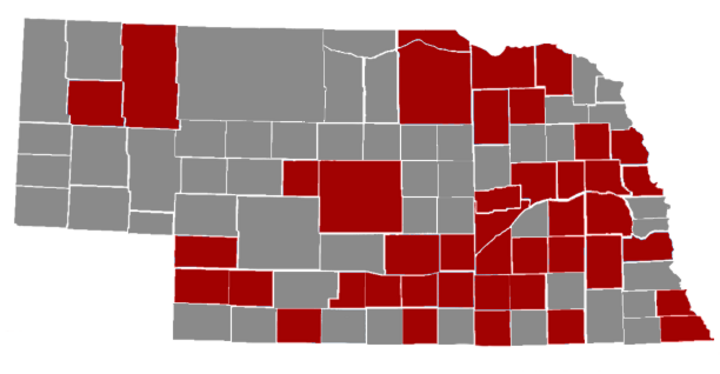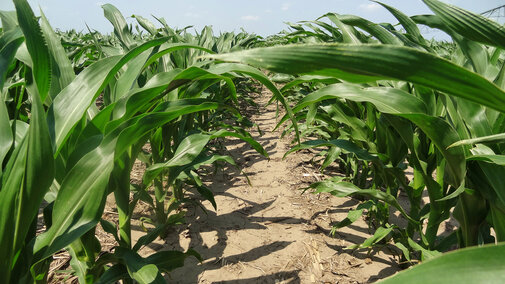This report synthesizes the results of seven Torque™ studies in Nebraska between 2010 and 2015. According to product information published by the manufacturer Monsanto BioAg, Torque is a growth promoter designed to improve soil microbial activity and enhance nutrient availability. In these studies Torque was applied as an in-furrow application.
| Year | Location | Soil Texture | Previous Crop | Planting Date | Planting Rate (seeds/ac) | Row Spacing (inches) | Tillage | Irrigation |
|---|---|---|---|---|---|---|---|---|
| 2010 | Dodge | — | — | 4/26/2010 | — | — | — | Pivot |
| 2011 | Dodge | — | Corn | 5/3/2011 | — | — | — | Pivot |
| 2013 | Clay |
Silt Loam |
Corn | 5/10/2013 | 34,000 | 30 | Conventional | Pivot |
| 2014 | Clay | Silt Loam | Soybean | 5/1/2014 | 33,000 | 30 | No-Till | Pivot |
| 2014 | York | Silt Loam | Soybean | 4/29/2014 | 34,000 | 30 | Ridge | Pivot |
| 2014 | Saunders | Silty Clay Loam | CRP | 5/18/2014 | 26,000 | 15 | No-Till | None |
| 2015 | Saunders | Silty Clay Loam | Soybean | 5/22/2015 | 28,000 | 15 | No-Till | None |
| * Detailed site characteristics and production practices are not available for all sites. In these cases, a dash is used to indicate the data is not available. | ||||||||
The product was applied at a rate of 8 oz/acre in all studies except the two Saunders County studies, where it was applied at a rate of 16 oz/acre. Site-specific data is included in Table 1. Most studies reported data for yield and grain moisture; this data is presented in Table 2. Torque's active ingredient of 2 x 10-7 percent lipo-chiooligosaccharide (LCO) is formulated for corn applications in an aqueous carrier accounting for more than 99% of the product.
| Study Information | Moisture (%) | Yield† (bu/ac) | |||||||
|---|---|---|---|---|---|---|---|---|---|
| Year | County | Reps* | Torque | Check | P-Value | Torque | Check | Diff. | P-Value |
| 2010 | Dodge | — | 15.2 | 15.3 | 0.052 | 178 | 180 | -2 | 0.357 |
| 2011 | Dodge | — | 16.3 | 16.3 | — | 184 | 188 | -4 | 0.055 |
| 2013 | Clay | 8 | 18.4 | 18.4 | 0.632 | 255.3 | 254.8 | 0.5 | 0.764 |
| 2014 | Clay | 6 | 16.9 | 16.8 | 0.175 | 284 | 283 | 1 | 0.216 |
| 2014 | York | 6 | 17 | 16.9 | 0.102 | 204 | 205 | -1 | 0.382 |
| 2014 | SaundersA | 5 | 16.9 | 16.4 | 0.18 | 181 | 164 | 17 | 0.014 |
| 2015 | SaundersA | 8 | 14.64 | 14.58 | 0.045 | 215 | 213 | 2 | 0.149 |
| * Number of replications is not available for all sites, however Nebraska On-Farm Research Network standards require a minimum of three replications for inclusion. † All data except for the 2010 data is corrected to 15.5% moisture. A Indicates that Torque was applied at a rate of 16 oz/acre at the site. At all other sites, Torque was applied at 8 oz/acre. Indicates yield is significantly lower for the Torque treatment at alpha = 0.1. Indicates yield is significantly higher for the Torque treatment at alpha = 0.1. |
|||||||||
Summary In one of seven studies applying Torque resulted in a 17 bu/acre yield increase. At another site, Torque resulted in a 4 bu/acre yield decrease. The remaining five sites saw no statistical yield difference for using Torque.
This report has been posted to the Compendium of Research Reports on Use of Non-Traditional Materials for Crop Production, a searchable compilation of university research reports on non-traditional soil amendments and growth stimulants.
Nebraska On-Farm Research Network
For more information about the Nebraska On-Farm Research Network and to view other study results, visit https://cropwatch.unl.edu/on-farm-research.
Growers are currently working with Extension educators and specialists to establish protocols for 2018 studies. If you're interested, contact your local extension educator soon.

Find More Results from Nebraska On-Farm Research
A searchable database allows you to search over 600 studies dating back to 1990 by using keywords, filters, or an interactive county map. The results can also be sorted by year, comparison, county, irrigation status, crop, and topic. Learn more about this easy-to-use tool and see what other growers are testing and what might have application for your operation.

